
Tisane or caffeine free herbal tea with blue pea and chamomile tea, HolyBasil and mint. A refreshing and flavorful drink with numerous health benefits. Enjoy the delicious aromatic tea warm or chilled.
According to Wikipedia Herbal teas—less commonly called tisanes are beverages made from the infusion or decoction of herbs, spices, or other plant material in hot water. The term “herbal tea” is often used in contrast to true teas, which are prepared from the cured leaves of the tea plant, Camellia sinensis.

Tisanes or caffeine free herbal tea can be served hot and cold both. I have used Organic Blue pea and chamomile tea bags or herbal infusion to make this tea. But if you don’t have blue pea tea then you can use any green tea bag. And I have Ceylon cinnamon dip bags or pouch so I used it. These herbal infusion bags are full of strong cinnamon flavour. But you can also use cinnamon powder if you want.
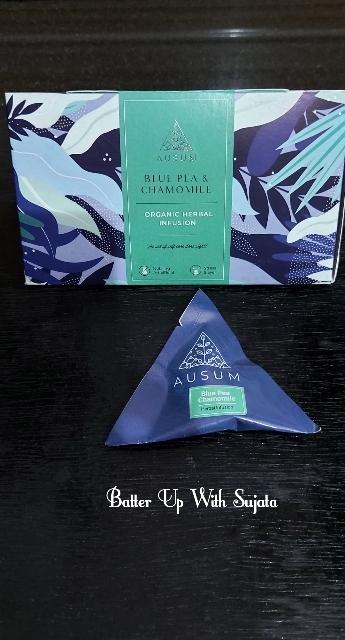

To get one more herbal tea click here. This blue pea tea looks beautiful blue in colour but when you add lemon juice it becomes purple.
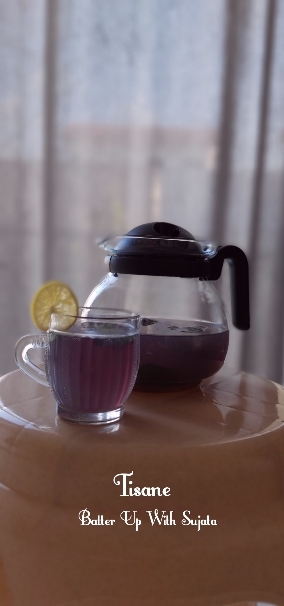

Ingredients used in this herbal tea.
1. Blue pea and chamomile tea. Blue Tea is made by seeping dried butterfly-pea flowers in water and can be enjoyed both hot and cold. It is also said to have weight loss benefits. Blue tea is said to have detox and weight loss benefits Blue tea is caffeine-free and a good alternative to tea or coffee. While chamomile is very well-known for its mild and soothing flavour that acts as a stress buster. To read more about blue pea tea click here.
Cinnamon. The spice comes from the inner bark of a small evergreen tree. The bark is peeled and laid in the sun to dry, where it curls up into rolls known as cinnamon sticks. Cinnamon is also available in powdered form. It has anti-viral, anti-bacterial and anti-fungal properties. Contains antioxidants with anti-inflammatory effects. Its prebiotic properties may improve gut health. Reduces blood pressure. Lowers blood sugar and risk of type 2 diabetes. Relieves digestive discomfort. Source
Tulsi or Holy Basil From the leaves to the seed, holy basil is considered a tonic for the body, mind, and spirit. Different parts of the plant are recommended for treating different conditions. The nutritional valueTrusted Source is also high, as it contains: vitamin A and C, calcium, zinc, iron, chlorophyll. Holy basil has been shown to boost your body’s health in a variety of ways. It can help protect against infection, lower your blood sugar, lower your cholesterol, ease joint pain, and protect your stomach. Source – Healthline
Lemons are high in vitamin C, fiber, and various beneficial plant compounds. These nutrients are responsible for several health benefits. Lemons contain a high amount of vitamin C, soluble fiber, and plant compounds that give them a number of health benefits. Lemons may aid weight loss and reduce your risk of heart disease, anemia, kidney stones, digestive issues, and cancer. Not only are lemons a very healthy fruit, but they also have a distinct, pleasant taste and smell that make them a great addition to foods and drinks. Source
Mint makes a delicious and healthy addition to many foods and beverages. Mint’s health benefits range from improving brain function and digestive symptoms to relieving breastfeeding pain, cold symptoms and even bad breath. To know more click here.
Rock salt or Sendha namak, a type of salt, is formed when salt water from a sea or lake evaporates and leaves behind colorful crystals of sodium chloride. Sendha namak, or rock salt, has long been used in Ayurvedic medicine to boost skin health and treat coughs, colds, and stomach conditions. Sendha namak is highly valued in Ayurveda, a system of alternative medicine originating in India. According to this tradition, rock salts offer numerous health benefits, such as treating colds and coughs, as well as aiding digestion and eyesight. Source

So here is a healthy and aromatic warm drink to enjoy in the Monsoon. You may also like this hot delicious Lemon coriander amla soup by Swaty Malik As I mentioned above that you can serve this caffeine free herbal tea hot or cold. If you don’t have blue pea tea then you can use green tea instead. I used ginger powder as I always use it in my regular Herbal tea But you can use fresh ginger. Just grate the ginger before adding in the water. And instead of Cylon cinnamon dip bag you can use 1 teaspoon Cinnamon powder.

Recipe
Blue pea and chamomile tea bags or green tea bag – 2
Tulsi or HolyBasil – 15 leaves
Cinnamon dip bag – 1, or 1 teaspoon Cinnamon powder
Lemon – 4 slices
Dried ginger powder or fresh grated ginger – 1 teaspoon
Mint – 15 leaves
Rock salt – a pinch
Honey to taste, optional
Water – 4 cup
Lemon juice – 2 – 3 teaspoon or to taste
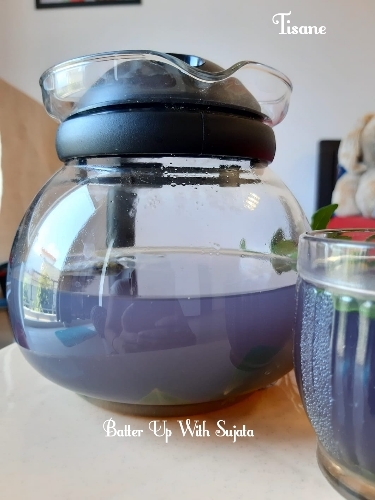
Method
1. Boil the water with tulsi or Holy basil leaves, dried ginger powder, rock salt and mint leaves for 5 minutes.
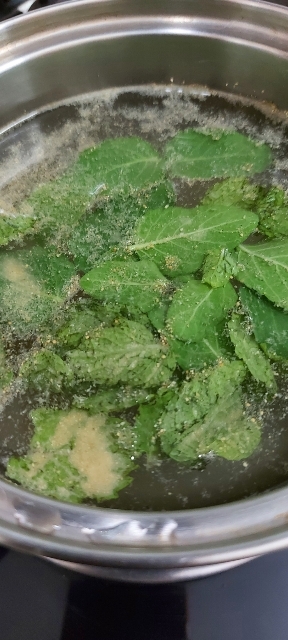
2. In a teapot place teabag and cinnamon pouch. Pour the boiled water with tulsi, mint leaves and dried ginger. Also add a few fresh tulsi, mint leaves and lemon slices.
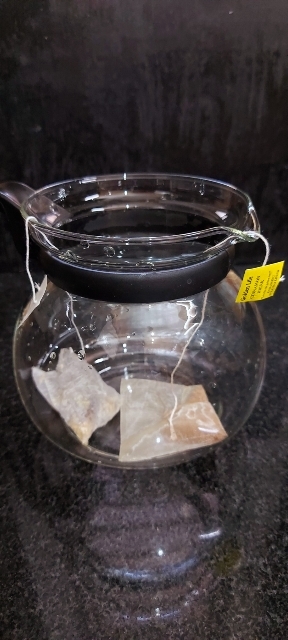
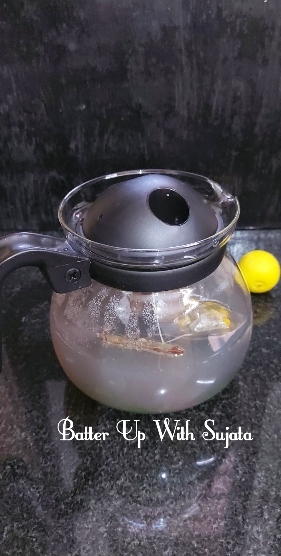
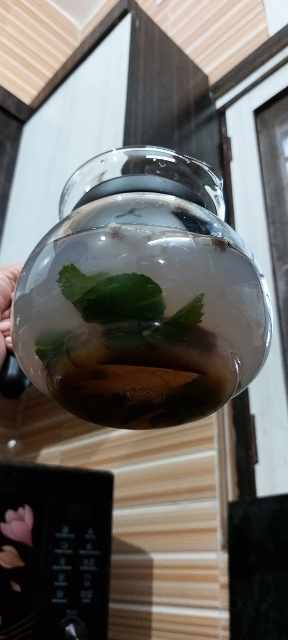

3. Cover the teapot and let it steep for 5 minutes.
4. Now strain the tea in cup. Add honey and lemon juice to taste. Enjoy caffeine free refreshing and flavorful warm blue tea anytime. Or let it cool down and serve chilled with some ice cubes. Or refrigerate the tea and serve chilled.
Notes
1. If you don’t like your tea sweet skip honey.
2. You can use any sweetener instead of honey.
3. Green tea bag can be used instead of blue pea teabag.
4. You can also use cinnamon powder instead of cinnamon dip bag.
If you tried my recipe, you can share your food pictures with me in the social network sites by using hashtag, #batterupwithsujata I would love to see your creations.
I would love to hear from you. Please share your thoughts and suggestions in comment.
Please visit my facebook page and hit the like button to get the latest update
Follow on

Love the gorgeous color of this herbal tea and the flavors you have used to make it. Sounds absolutely refreshing and soothing!
LikeLiked by 1 person
Sp appealing to eyes and must be great for taste buds… the color also looks so beautiful.. I have still to try drinks using the butterfly pea flowers ..I will lookout for the tea bags so that I try this healthy and comforting tea.
LikeLiked by 1 person
I love herbal tea and this one sounds amazing. Love all the ingredients you have to used to make this delicious tea. I have had butterfly pea tea but not with camomile . Very flavourful tea perfect for the cool wet weather here.
LikeLiked by 1 person
My first experience with butterfly pea tea was in Thailand, after which I started making it at home. However, I’ve never had it with ingredients like ginger, rock salt, mint, dry ginger powder and holy basil. Your version sounds so much more interesting and flavourful!
LikeLiked by 1 person
This is just wow sujata ji . So many aromatic and exotic flavors steeped in the form of tea is most comforting when it is pouring cats and dogs outside and we just want to relax and enjoy the pitter patter of rain drops
LikeLiked by 1 person